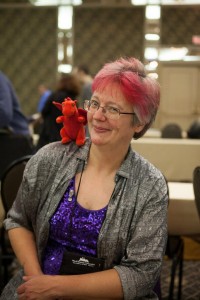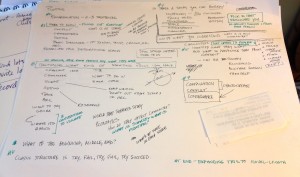
And I’m really happy with it, but holy cow, is it hard to rewrite a novel. Because you’ve got to manage it all in your head while working with smaller parts of it.
I was trying to think of a comparison to make to Wayne, who is a software developer. And actually, it’s a lot like working on a large program with pretty of submodules and pieces, because when you change one section you need to figure out how it affects all the other pieces. And there’s repeated objects, or other things, and I think a little of those like global variables, so to have to make sure they’re declared before you can start using them. (As you can tell, I spent some procrastination time on thinking this out.)
Something I’m doing, which is probably rather insane of me, is that I transferred the book, which was in a Word doc, back into Scrivener. That’s because I have been severely reordering the scenes. I printed it all out, and went through that hardcopy with pen marking up some stuff and shuffling it around until it was all in the order I wanted it in.
Part of that is the process for dealing with what I’m comparing to global variables. That’s a thing that gets referenced more than once over the course of the book. Because you want it set up right the first time it appears and then for details to unfold about it in an order that makes sense and keeps building on the thing.
For instance: Bella has five Fairies, hummingbird-sized, living in the pine tree outside her window. She’s tamed them with table scraps and candies, and listened to them enough to understand their rudimentary language and call them by the names they call themselves:
Where another might have named them, I’ve listened long enough to know the names they have for themselves: Dust and Yellowhair, and their offspring, Finch and Flutter and Wall. They shelter in the evergreen, build nests of scraps of paper and rags. In this cold, they wrap bits of cloth around themselves in mimicry of clothing.
They like candy the best, but meat second to that, the fresher and bloodier the better. They scorn vegetables or breads, though they will take fruit, when it is at its ripest, just before it spoils.
They trust me.
Any mention of the Fairies that uses their names needs to come after this passage, which establishes. Later on, we find out one is getting picked on by its fellows:
Yellow-hair hangs in the air, watching me. But it’s not till I step back from the sill that she advances, dives to seize a candy, a ball of amber sugar as big as her head. As though she’s emboldened them, the rest come in turn. I try to see which of them might be looking more bedraggled than the others, but I can see little difference.
Jolietta kept chickens. There you’d see it. One more miserable than the rest, pecked and sat upon, with ragged bald patches. Animals have no patience for the weak, nor do Beasts. Is one of the Fairies ailing, perhaps? It seems to me there are fewer than usual. When they’ve taken their candies, I go back to the window, lean out despite the cold wind, and peer into the boughs. There, that little shape, is that a huddled Fairy? Snowflakes whirl, obscuring the sight.
That in turn builds this moment:
I go to the window and look into the whirling snow. There’s a limp little form in the corner of the window. Wind and snow greet me when I slide the window up, but I manage to gather the half-frozen little Fairy. Finch.
He’s fought with his fellows. They must have tried to drive him away.
There’s more further on down the chain, but I think that’s enough spoilering for one blog post. But you see my point: set up an object (or person, or place, or concept, or whatever) and then build with it. As part of my reordering, I’ve been making sure that all happens in the right order, and that’s let me trim out some repetitious bits as well.
The book was, at one point, chockful of different POVs, and I was (somewhat reluctantly) persuaded to pare that down. It was the right choice, though, because it made me focus on the two most important characters, Bella and Teo. I wanted to make them very distinct from each other, so I switched Bella’s POV from third person attached past tense to first person present tense. Holy CRAP did that make her come alive and let me take a character who had been unsympathetic before into one that you can (I think) really enjoy and love even when she’s at her most full of braggadocio and self-absorption.
I was sad to lose a couple of POVs, particularly three which had a nice love triangle going on, but they’ve been set aside to go into the second book (this is intended to be a trilogy). But now I’m going back to that rewrite after this short break for air, so wish me luck.
I still don’t know what the heck the title is, really. And I’m not so sure about my main character’s name.
Enjoy this writing advice and want more content like it? Check out the classes Cat gives via the Rambo Academy for Wayward Writers, which offers both on-demand and live online writing classes for fantasy and science fiction writers from Cat and other authors, including Ann Leckie, Seanan McGuire, Fran Wilde and other talents! All classes include three free slots.
Prefer to opt for weekly interaction, advice, opportunities to ask questions, and access to the Chez Rambo Discord community and critique group? Check out Cat’s Patreon. Or sample her writing here.





 It’s always bothered me that fantasy and science fiction get lumped together into a single category. The two genres seem very different, at least on the surface. Fantasy usually features some kind of magic as a core speculative element. It often takes place in a secondary world at a pre-industrial state of technology. Science fiction, in contrast, usually takes us to the future in which some as-yet-nonexistent technology underlies the plot. Granted, there’s a huge overlap between fantasy and science fiction fandoms. Maybe that means we live for escapism, whether to a fantasy world or outer space.
It’s always bothered me that fantasy and science fiction get lumped together into a single category. The two genres seem very different, at least on the surface. Fantasy usually features some kind of magic as a core speculative element. It often takes place in a secondary world at a pre-industrial state of technology. Science fiction, in contrast, usually takes us to the future in which some as-yet-nonexistent technology underlies the plot. Granted, there’s a huge overlap between fantasy and science fiction fandoms. Maybe that means we live for escapism, whether to a fantasy world or outer space.



6 Responses
Whew. That is some serious retooling. I’m interested in Bella’s new POV–sometimes I love first person present, sometimes I find it jarring. But when it works (and I’m sure you’ve made it work well), the intimacy and immediacy are immensely rewarding.
Go go go!
Ugh, yeah. I also did the whole “transfer from Word to Scrivener” thing with my last novel draft. It was a huge pain, but it definitely made it easier to visualize the whole thing (and to move scenes around). I do wonder, though, how easy it will be to revise in Scrivener. I normally write scenes (chapters, books) anew, whereas Scrivener seems to lend itself better to in-line editing. On the other hand, I haven’t really explored its functionality very much.
@ RH: Do you know about the snapshot feature in Scrivener? Snapshots allow you to save multiple versions of the same scene without having to open new scenes/index cards for each version. It makes rewriting very handy because then you don’t have to worry about losing what you’ve written. Here’s a pretty good writeup about it for the Mac version: http://www.atfmb.com/2012/04/23/scrivener-quick-tip-snapshots/
Thanks Christina, that is very handy!
I’m very excited to read this when it gets published!